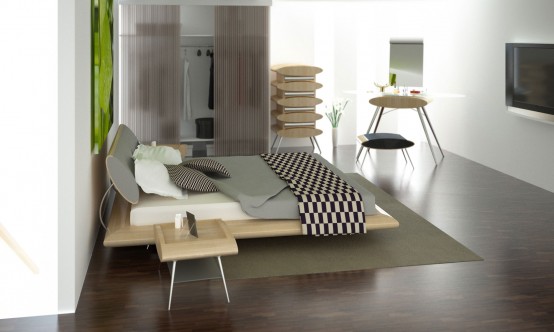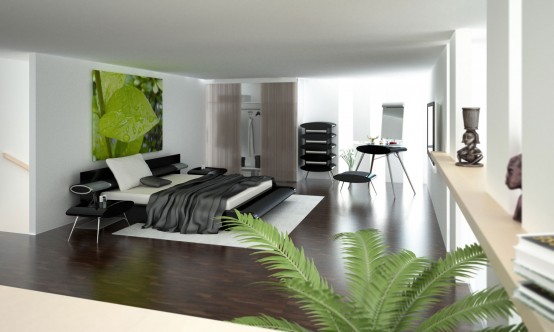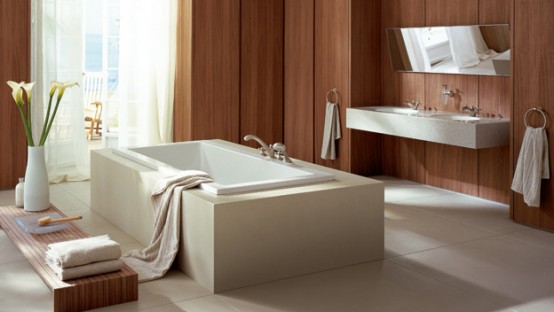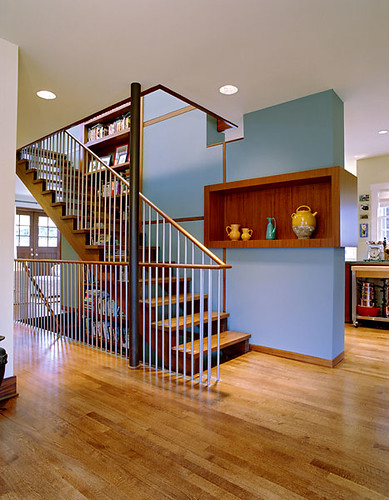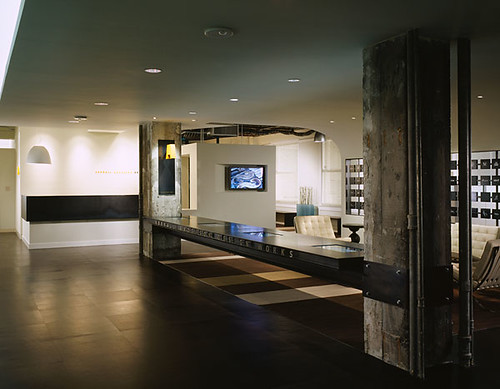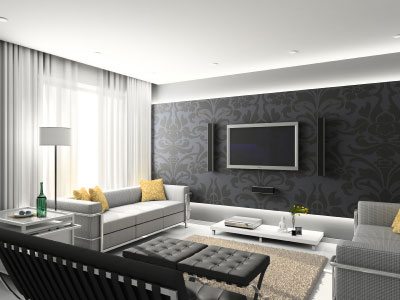|
|
|---|
Saturday, July 25, 2009
Labels: Modern Interiors Design
Sunday, July 19, 2009
 Flood lights are good ambient lights that also provide security measures. Many flood lights come with motion sensors, so they only come on if motion is detected. But if you're having a party and don't want a burst of bright light in the middle of the festivities, make sure to install ones that can be switched off as needed.
Flood lights are good ambient lights that also provide security measures. Many flood lights come with motion sensors, so they only come on if motion is detected. But if you're having a party and don't want a burst of bright light in the middle of the festivities, make sure to install ones that can be switched off as needed.
Accent lights can be used to highlight particular features in your yard. Smaller trees are great showpieces in a spotlight, and larger trees can reflect light back into the yard. Flowerbeds benefit from ground lighting that adds drama and beauty to your yard scene. And if you get the itch to do a little gardening at night, ground lights can also provide good task lighting.
If you have a deck with built-in seating, downlights add the feeling of candlelight for an intimate scenario. You don't want to over-light, so a good rule of thumb is to come up with a lighting scheme that mimics moonlight. You can choose from a variety of solar lights which are charged by sunlight, or low-voltage lights that connect to the electricity in your house. Solar lights are typically less expensive, but they also don't give off as much light. Low-voltage lights are more expensive and require additional equipment, but they offer considerably more light.
2: Natural light When asked to describe their most coveted space, many homeowners are quick to toss out adjectives like light and airy. Natural light is highly desirable light in a home, simply because it makes everything look appealing. Lighting schemes relying on natural light are called daylighting, and builders and architects are getting more requests than ever before to implement it in new construction. Perhaps it's because we spend many of our busy hours sitting at a desk indoors, but we didn't evolve that way. Daylighting keeps us in touch with the outdoors and time of day, and studies have found that people who work in natural light are more productive .
When asked to describe their most coveted space, many homeowners are quick to toss out adjectives like light and airy. Natural light is highly desirable light in a home, simply because it makes everything look appealing. Lighting schemes relying on natural light are called daylighting, and builders and architects are getting more requests than ever before to implement it in new construction. Perhaps it's because we spend many of our busy hours sitting at a desk indoors, but we didn't evolve that way. Daylighting keeps us in touch with the outdoors and time of day, and studies have found that people who work in natural light are more productive .
There are other benefits to natural light as well, such as a savings on electricity if you don't have to turn on lights. But making the best use of natural light is more detailed than throwing open your curtains and embracing the sun's rays. Glare can be an issue if the sun shines directly, or even indirectly, into the room. Heat also needs to be managed, which is usually best accomplished with curtains or shades. Painting a room a light, reflective color can help amp up the natural light, and the best ceiling color to complement the light is the whitest white you can find.
3: Task Lighting
Task lighting provides the primary light in a room, and is ideally six to 10 times brighter than the ambient light. It's used to increase illumination above ambient levels at workspaces, and carefully chosen task lighting can minimize the need for overhead lights, which is helpful in conserving energy. The term "task lighting" has noticeably popped up in the vernacular since home renovations have become all the rage. Task lighting for our ancestors often consisted of a bright lone bulb in a utilitarian desk lamp, but now the options are endless. It's a key element in the kitchen and office, where specific tasks requiring proper light are prevent. It's also useful in the living room for projects, or in the bedroom for reading, and helps to avoid eye strain. There are many different kinds of lights that perform the job of a task light. Under-cabinet down lights are helpful for kitchen tasks, because typically, your shadow gets in the way of the ambient light source. Desk lamps or floor lamps trained on a desk are useful in the office, and table lamps with high watt bulbs work well in the living room and bedroom. Halogen lights are ideal for task lighting because they're energy efficient and produce a clean, clear light that renders accurate colors. The downside is that they tend to burn hot, so computing for hours under a halogen bulb could produce a sweat bead or two.
4: Accent Lights Accent lights are directional lights whose main purpose is to provide visual separation in a room. They're secondary lights in a room, and as a rule of thumb, they should be be three to five times brighter than the ambient light level . Wall-mounted fixtures, such as sconces, are a good example of accent lights, as are table and floor lamps. For example, a chandelier in your dining room would provide ambient light, and one or more wall sconces would be the accent lights. Another use of accent lighting is to showcase a feature in a room, such as a painting or a collection. You've probably seen this in art museums.
Accent lights are directional lights whose main purpose is to provide visual separation in a room. They're secondary lights in a room, and as a rule of thumb, they should be be three to five times brighter than the ambient light level . Wall-mounted fixtures, such as sconces, are a good example of accent lights, as are table and floor lamps. For example, a chandelier in your dining room would provide ambient light, and one or more wall sconces would be the accent lights. Another use of accent lighting is to showcase a feature in a room, such as a painting or a collection. You've probably seen this in art museums.
The ambient light is usually dim, which invokes peace and quiet, and the accent lights highlight the paintings, keeping you focused on the art. You can do this in your home as well, and it doesn't have to be fine art. If you have a big, beautiful plant you want to highlight, you can put a spotlight on the floor behind it and let the light bounce off its leaves, creating shadows and drama. Typically, a spotlight or floodlight is used to accent an object, though tracklights also work in certain applications. Higher wattage incandescent bulbs are often used in table lamps and wall lights for accent lighting, and halogen lamps are primarily used in spotlights.
5: Ambient Lighting The purpose of ambient light is to create a diffused, even light level in a room, and it's the first place to start when creating a lighting scheme. Ambient light can also refer to a lighting scheme as a whole, but for our purposes, we'll be talking about ambient light sources. The source usually comes from lights on the ceiling, though sometimes table or floor lamps can do the trick. Overhead light sources can be a lone bright light, such as a ceiling or pendant light, or multiple lights, such as track lighting or recessed cans. These smaller lights all work together to create the main light source, but the difference is that they can be aimed at different areas of the room to get into all of the nooks and crannies.
The purpose of ambient light is to create a diffused, even light level in a room, and it's the first place to start when creating a lighting scheme. Ambient light can also refer to a lighting scheme as a whole, but for our purposes, we'll be talking about ambient light sources. The source usually comes from lights on the ceiling, though sometimes table or floor lamps can do the trick. Overhead light sources can be a lone bright light, such as a ceiling or pendant light, or multiple lights, such as track lighting or recessed cans. These smaller lights all work together to create the main light source, but the difference is that they can be aimed at different areas of the room to get into all of the nooks and crannies.
Most overhead lights use incandescent bulbs, which are inexpensive and come in a variety of wattages. Compact fluorescent bulbs also have come on the scene as "green" alternatives that cost a little more but last considerably longer than their incandescent counterparts. They also have the benefit of being recyclable, whereas regular light bulbs are not. The downside is that fluorescent lights have a reputation for casting unattractive light, but manufacturers are continually working to improve this. No matter what bulb you use, overhead lighting is practical but it can be garish, so ambient light sources need to be complemented with other kinds of lights to provide contrast. In the next section, we'll talk about accent lighting.
Labels: Light decor, Lighting Decorate
Friday, July 17, 2009
 Modern Teen Girl Bedroom Decorating Ideas,opens up even more problems, especially if the girl in question is a teenager. If you’re the parent of a teen girl, then the first thing you should do is discuss her ideas. Although it’s your house, it is her bedroom after all, and she still needs to feel comfortable in what is essentially her haven. A teen girl’s bedroom is a very personal sanctuary where her dreams and ambitions take shape. It’s where a girl can express herself, explore her feelings, and develop her own personal style. For those of you who are looking for a teen bedroom here is an idea that is awesome for small spaces. As you can see from the pictures, with a simple gesture you can pull the bed. The movement is light and easy grasping the handle comfortable bed moves revealing corridor access. Under the bed is a small office where you can place a computer to check your favorite blogs in the morning.
Modern Teen Girl Bedroom Decorating Ideas,opens up even more problems, especially if the girl in question is a teenager. If you’re the parent of a teen girl, then the first thing you should do is discuss her ideas. Although it’s your house, it is her bedroom after all, and she still needs to feel comfortable in what is essentially her haven. A teen girl’s bedroom is a very personal sanctuary where her dreams and ambitions take shape. It’s where a girl can express herself, explore her feelings, and develop her own personal style. For those of you who are looking for a teen bedroom here is an idea that is awesome for small spaces. As you can see from the pictures, with a simple gesture you can pull the bed. The movement is light and easy grasping the handle comfortable bed moves revealing corridor access. Under the bed is a small office where you can place a computer to check your favorite blogs in the morning.


Labels: Bedroom Decorating Ideas
Monday, July 13, 2009
 Interior design ideas these days are dime a 12. If you watch a television show that is dedicated to interior designing for one hour, once you come out, you would have enough knowledge that you can design for complete home. The main drawback of a television show when compared to applying these ideas in life is these are tough to document. If you don’t sit next or in front of the TV and scribble down madly onto paper piece, it is really difficult to remember all the ideas that you get watching the show. The key for a successful interior designing is planning.
Interior design ideas these days are dime a 12. If you watch a television show that is dedicated to interior designing for one hour, once you come out, you would have enough knowledge that you can design for complete home. The main drawback of a television show when compared to applying these ideas in life is these are tough to document. If you don’t sit next or in front of the TV and scribble down madly onto paper piece, it is really difficult to remember all the ideas that you get watching the show. The key for a successful interior designing is planning.
Replicating or trying to copy an idea or design from a TV show for your home could include additional planning or steps which might not be shown in an hour or a thirty – minutes of a show. This being the reason it is necessary for one to go through the entire dry run of the design or idea before we actually execute it. There is a fair chance for figuring out and taking corrective measures to make sure a hassle free application.
The only resource for ideas and information for interior designs is not Television. Books always remain as a better help for designers of any experience and background. The information we get in the books is more or less explanative and thought-out material when compared to a TV show. As book demand more basic information and material than a Television show can have in a limited segment of time. Not only this, books are written by two or three authors together for such subjects and are also edited before it is released to the readers in any form. So, the information would be edited and re-written by two to three parties. Exceptions for the rules are always there but, this would be the normal scenario.
If you feel reading a book is time consuming for tedious task, then you can always choose to read a magazine article as another source of information for interior design. You always have the benefit of pictures or visual representations of the designs and its concepts in a magazine that you can look into or hold on for a particular period of time. Professional interior designers collect all these articles in big numbers along with the visuals and keep them in a format that can be accessible to everyone easily. This is a perfect source for getting specific information, feel or look that is difficult to describe in actual terms of industry for a client. Terminology used in these articles are self-explanatory although people who don’t have much expose to this jargons might find it difficult to understand few phrases or concepts that are used to define the interior design areas. Most of us are aware of the words ‘modern’ and ‘traditional’ design but, the magazines would not find it difficult to say ‘Americana’ or ‘Minimalist’ for these terms. You need not think its incomplete just because you are not aware of these phrases, you have to understand that the process of learning takes time and hence is exactly termed as a process.
If you have enough creative ideas with you, go through different magazines and have an unique and distinct style design for your work that are within the ideas and guidelines for interior designing. If you feel you are not much comfortable with your style and find it easy in the traditional design segment, then collate all the ideas pertaining to this category and stick to the ideas or guidelines provided in the information you have collected.
Taking a little of information from these various sources and compile them into a creative collection of ideas that can help you access this information any time in future to compare with your own vision and ides would be a best way to understand information.
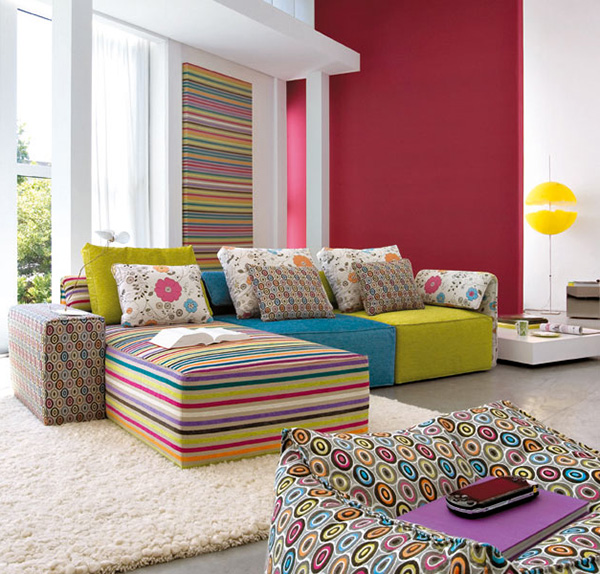


Labels: Interior Design
Friday, July 3, 2009
Modern Wall Units
Living room looking a bit dull? Go for the sleek, sexy and stylish Regolo Wall Unit Collection from Italian furniture maker Jesse to bring a little gloss and glamour to your living room. These modern wall units form a convergence of style and functionality and they can transform pretty much any space into a futuristic entertainment base.











Labels: Furniture Designs


